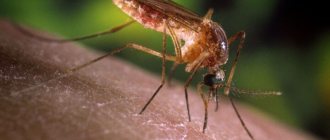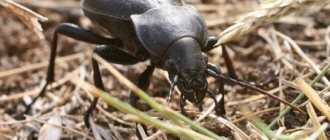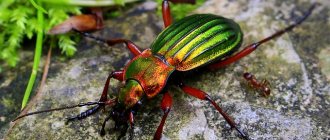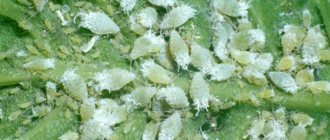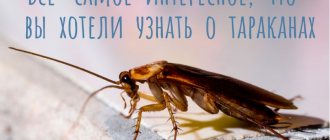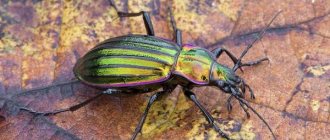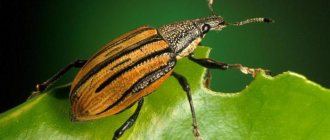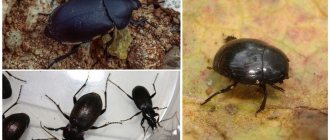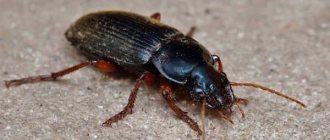Insects are multicellular invertebrate animals belonging to the most multi-species class of the arthropod phylum. There are more than 1 million species of insects.
Entomology is a branch of zoology that studies insects.
Insects include flies, beetles, butterflies, ants, bees, dragonflies, locusts, bedbugs, aphids, etc. Most live on land, flying through the air or crawling on the ground.
Aquatic representatives include swimmers, smoothies, water striders, etc.
There are parasitic forms that settle on the body of humans or animals (fleas, lice, bedbugs).
Under the ground you can find mole crickets and others.
Features of the external structure of insects
Unlike crustaceans and arachnids, the body of insects is divided into a head, thorax and abdomen. The number of legs corresponds to three pairs (sexapods).
External structure of an insect
Just like all arthropods, the body of insects is covered with chitin. Chitin forms the external skeleton of the animal. During the growth of the insect, the chitinous cover is shed - molting.
Many insects have organs of touch and smell in the form of antennae. Antennae can have: filamentous, serrated, comb and feathery structures.
The movement of insects is provided by legs and wings located on the chest.
The structure of insect legs depends on their lifestyle and habitat. The following types of limbs are distinguished: running (ants), swimming (diving beetle), jumping (grasshoppers) and digging (dung beetle, mole cricket).
Types of Insect Limbs
One or two pairs of insect wings vary in density, color and arrangement of veins. The wings of butterflies (Lepidoptera) have a scaly structure.
The abdomen of insects includes from 5 to 11 segments.
Depending on the type of food, different groups of insects have unique mouthparts: piercing-sucking (mosquito, forest bug); filter-licking (fly); sucking (butterfly); gnawing (beetles); gnawing-licking (bee).
Other types of mouthparts
Filter type
The described varieties belong to the main types of mouthparts, however, among smaller and less numerous orders there are also other modifications. For example, in some aquatic animals, the larva (or larva) is an immature phase of post-embryonic development during which the main growth processes occur in arthropods.
More details by following the link
More details by following the link
“>larvae of many midges (Simuliidae), a kind of fan develops on the head, designed to filter microorganisms. Based on the mechanism of operation, this type of apparatus is called filtering.
Cutting and sucking type
More details by following the link
More details by following the link
“>maxillae - into long piercing stilettos. Both pairs of jaws cut and pierce the integument of the body of mammals, causing bleeding from the wound. This blood is collected by a sponge-like structure on the Labium (or lower lip) - the part of the oral apparatus located opposite (behind) the upper lip and involved in eating.
More details by following the link
More details by following the link
More details by following the link
“The hypopharynx fit tightly together, creating a tube through which blood rises into the esophagus.
Tubular-sucking type
Adult Lepidoptera feed on nectar and other liquid food. It is absorbed using a long proboscis formed by folded together galea and maxillae (or lower jaws) - part of the oral apparatus of insects, the second pair of jaws responsible for grinding and/or delivering food to the mouth.
More details by following the link
">maxillae. The result is a tube that opens into the esophagus. This type of structure is called the tubular-sucking type of mouthparts.
Source
Orders of insects
The incredible diversity in the structure of insects allows us to differentiate them into orders so that their study can be effective. The key point of whether an insect belongs to a particular order is the structure of the mouthparts, wings and type of development. In this article we will look at the most basic orders of insects.
Remember that all insects have indirect development. Indirect development can be with complete transformation or incomplete.
Orthoptera
Representatives of this order are: grasshoppers, crickets, locusts, mole crickets. The locust differs from the grasshopper in having short antennae.
Most often they have an elongated body. The mouthparts are gnawing type. The forewings are leathery, straight, fold along the entire body, and quite narrow. The hind wings are wider than the front wings, membranous, with radially arranged veins.
Representatives: silkworm, cabbage white, night peacock, mourning moth, admiral, swallowtail, bear, moths, moths.
Diptera
Representatives of the order: mosquitoes, flies, gadflies, horse flies, midges.
The head is connected to the body through the so-called cervical region, which ensures the mobility of the head. The mosquito has a piercing-sucking type of mouthparts and very long antennae. The housefly has a licking mouthpart and short antennae.
House flies carry pathogens of intestinal infections and helminth eggs. Their white worm-like larvae develop in sewage, garbage dumps, and manure. In one summer, 6-9 generations of flies develop.
The development of dipterans is indirect with complete transformation (metamorphosis). A larva emerges from the egg, which does not resemble the adult. As a result of metamorphosis at the pupal stage, an adult individual (imago) is formed.
Hymenoptera
A number of ichneumon species are successfully used by humans as a method of biological control of flies and beetles, and caterpillars that harm crop plants.
Development is indirect with complete transformation (metamorphosis). The larvae do not resemble the adult; most have a worm-like body shape and lack walking limbs.
Beetles (Coleoptera)
Representatives: May beetle, Colorado potato beetle, swimming beetle, gravedigger, dung beetle, scarab, ladybug, bark beetle.
The gravedigger beetle does not feed exactly as its name might suggest: sensing the smell of carrion, these beetles find the corpses of animals and, by digging out the ground from under them, contribute to their burial. The beetles chew through roots and herbs that interfere with burying the corpse and feed on it. They lay their larvae in the dead tissues of the animal, which feed on the remains of the animals.
Development with metamorphosis (complete transformation), typical stages: egg, larva, pupa, imago (adult). The larvae have a gnawing type mouthpart, a well-developed chitinized head, and most have articulated thoracic limbs.
Bedbugs
I note that at the moment in taxonomy, bedbugs are a suborder included in the order Hemiptera. Representatives: bedbug, stink bug, keelweed.
The mouthparts are of the piercing-sucking type; many bedbugs are predators and parasites: they pierce the skin of an animal or the epidermis of a plant, after which they suck out blood or juices, respectively.
It is obvious that some bedbugs are blood-sucking parasites of humans; some species cause significant damage by feeding on plant sap: they deplete plants and reduce productivity.
Most bedbugs are characterized by the presence of odorous glands on their abdomen, the secretions of which have a specific odor that is unpleasant to humans. It is probably the smell that helps them scare off enemies.
Development with incomplete transformation: a larva emerges from the egg, which is externally similar to the adult organism (imago), but smaller in size.
Mayflies
Adults are characterized by an underdeveloped oral apparatus; they practically do not feed. Larvae, unlike adults, feed actively, mainly on plant remains, and have a developed gnawing-type mouthparts.
The adult individual has two pairs of mesh transparent wings, the largest of which are the front ones. At the end of the abdomen there are three or two characteristic tail filaments.
Dragonflies
Representatives: yellow, flat dragonfly, brilliant beauty, large rocker.
Characterized by the presence of two pairs of wings with a developed dense network of veins and an elongated slender abdomen. Large eyes are located on a large head, the body size is relatively large.
Development with incomplete transformation. The faces develop in water (lakes, ponds, rivers). Adults have mastered the air habitat.
© Bellevich Yuri Sergeevich 2018-2021
This article was written by Yuri Sergeevich Bellevich and is his intellectual property. Copying, distribution (including by copying to other sites and resources on the Internet) or any other use of information and objects without the prior consent of the copyright holder is punishable by law. To obtain article materials and permission to use them, please contact Yuri Bellevich
.
Source
Gnawing type functions
The gnawing oral apparatus serves its owner not only as an effective organ of nutrition , but also as a means of protection from predators and trespassers: the antagonist muscles that move the mandibles apart in the horizontal plane have remarkable strength, because it is with the help of them that ants can hold objects of several thousand times heavier than yourself. Such a bite is not dangerous (if the beetle does not have poisonous glands), however, it is quite painful and can distract the enemy for a short time, giving the beetle the opportunity to escape unharmed.
The food of beetles with a gnawing type of structure often
becomes smaller beetles and (examples of such predators are ground beetles, ladybugs), parts of plants or the entire plant (many species of caterpillars, grasshoppers, locusts). Polite or paper wasps use their mandibles to tear off small sections of bark and old wood from dry stumps, then “chew” them, thoroughly mixing them with sticky saliva and turning them into a kind of sticky papery mass that is quite strong and hard when dry. The nest will subsequently be built from it.
The structure of the oral apparatus varies greatly among different beetles due to dietary preferences, habitat, size of the beetle and its place in the ecological niche. However, the above general scheme will be true for any beetle.
Features of the structure of the housefly: how the wings and mouthparts are structured
The housefly (in Latin the name of the insect sounds like Musca domestica) is considered the most common among the numerous representatives of the class.
In zoology, it is customary to distinguish two types of winged insects: typical and southern houseflies.
The latter is distinguished from the indoor subspecies by its larger size. Let's consider the structural features of the housefly, how the wings and mouthparts of the insect are arranged
Reproduction
Mosquitoes feed on flower nectar. Even the females. But females need blood for successful and abundant oviposition. This is what causes their “bloodthirstiness”.
The female common mosquito (squeaker) attracts the male with a characteristic sound. That's why she still has her halteres. It does not buzz, but squeaks solely because of its size. Wings that are too small cannot produce a bass hum. If you hear a squeak in a swarm of mosquitoes, you can be sure that there are also females thirsty for blood there.
Even scientists have not yet been able to tell everything about mosquitoes when writing dissertations. However, many interesting facts about mosquitoes have been collected and you can get a general idea of how the bloodsucker that prevents you from sleeping works, and why it prevents you from sleeping with its squeaking.
Experts call the structure of a mosquito primitive, but if you carefully examine each part of it, you get a completely different impression. Everything in a small organism is thought out to the smallest detail. The abilities of insects have been studied for many years by specialists from different countries. One of the most famous creatures on the planet, but not fully studied. Everything about mosquitoes, their structure, features is further in our article.
Distinctive features of the house fly
House flies have several distinctive characteristics that allow them to be recognized among other subspecies.
The body of the insect is in most cases gray in color. The lower segment of the head received a yellow color.
The upper part of the chest is decorated with four black stripes. Black spots of regular quadrangular shape are visible on the abdomen.
Its lower part has a slight yellowish tint. The insect's body size reaches six to eight millimeters.
Differences between males and females
How a mosquito works depends on its gender. There are differences in the external and internal structure.
Female and male mosquito
- The mustaches of females are long and elongated; in males they are covered with thick flagella and have the shape of brushes.
- Females have a more rounded abdomen and a darker color. Larger body size.
- Males have more developed hearing, which makes it easy to detect the squeak of a female. In females, sensory abilities predominate, helping to determine the location of the victim.
- The mouth of males is limited to elongated lips, a tube for absorbing nectar. The trunk lacks teeth and barbed needles.
The male feeds on flower nectar and pollen and spends most of its life in vegetation. Females hunt animals and people, so they often catch the eye of humans.
Features of the structure of the house fly
The main difference between the housefly and other relatives is the presence of only one pair of wings.
During the evolution of the insect, the second posterior pair turned into haltere appendages used to maintain balance.
In addition, the insect, despite the complex structure of the eye, is blind. The visibility limit is limited to a distance of 40 - 70 cm.
External structure
The skeletal structure of the housefly is no different from other classes of insects.
Represented by the head, chest and abdomen. The head is equipped with mouthparts, eyes and antennae.
The chest has a segmental structure - there are three of them. There are two wings, they are completely transparent. Legs - three pairs.
Well-developed muscles are located in the chest cavity. Inside the abdomen are located the main part of the digestive organs and the entire reproductive system.
Breast
The chest is represented by three interconnected segments. The prothorax, midthorax and metathorax are distinguished.
The insect gains the ability to fly due to its powerful muscles, so the middle segment is the most developed.
The body is equipped with three pairs of legs, each of which is divided into five interconnected particles. The paws have well-developed muscles.
At the tips of the paws there are miniature claws and suction cups, with the help of which the insect is able to attach and hold on to any surface.
Thanks to this, houseflies have the ability to move upward with their abdomen. During movement, a sticky secretion is released from the pads as a result of compression.
This feature helps the fly to hold firmly on the glass and absolutely smooth surface.
The housefly's legs serve as olfactory organs. Thanks to the villi receptors located on them, the insect will determine whether food is edible or inedible.
Head
The structure of a fly's head is simple. On its surface are the organs of vision, hearing and nutrition.
The mouthparts of a fly - the structure depends on the type of food the insect eats - is represented by a proboscis of a licking or sucking format.
The lips, represented by the lower and upper blades, come into direct contact with the food mass.
A large number of channels through which food enters the digestive system converge in the food proboscis of the fly.
The fly has a powerful jaw apparatus. The mouthparts of the fly, whose diet is based on blood, have sharp and hard scales.
This is a kind of imitation of teeth that help the fly damage the surface of human skin. The pump located in the pharynx is responsible for drawing in liquid and liquefied food.
Most of the surface of the head is occupied by the eyes, which have a very complex structure. They are composed of a large number of simple eyes.
Visually – when zoomed in significantly – it looks like a faceted mesh.
This structure provides the housefly with a comprehensive image of objects, but the overall picture is perceived as a mosaic.
The total number of simple eyes of a housefly reaches 4 thousand. The insect is able to instantly react to any movement, but it does not receive a full-fledged three-dimensional image.
The antennae are used by insects as landmarks. They help in perceiving different smells and determining the direction of flight and movement. They have characteristic differences in females and males.
Wings
The structure of a fly's wing is simple. The insect has one pair of wings. They are well developed, completely transparent, and have membranes.
The strength of the wing is ensured by the cylindrical veins running through it. The posterior pair was transformed into haltere appendages during evolution. Wings help the fly maintain balance during flight.
In addition, they allow you to hover in the air if necessary. During the flight they emit a characteristic buzzing sound.
In flight, a housefly can turn off one of its wings, which helps it sharply change its flight path, perform complex maneuvers, and take off from a standstill without a preliminary run-up.
Belly
The abdomen of a housefly has the shape of an elongated cylinder.
Segmental, represented by ten interconnected segment particles.
Inside the abdominal cavity there are organs of the reproductive, respiratory, digestive and other vital systems.
The surface of the abdomen is covered with a chitinous layer with good elasticity. If necessary - after eating and during the period of bearing offspring - the cover can expand.
Internal structure
The internal structure of the fly is represented by the digestive system, reproductive system and other organs important for the life of the insect.
Digestive system
The abdominal cavity of the insect contains the main part of the organs responsible for and ensuring the absorption of food.
The housefly does not have a digestive system in its direct sense. Food is digested before it enters the insect’s gastrointestinal tract, i.e. food enters the cavity of the goiter in a form completely ready for absorption. Before the fly begins to absorb food, it treats it with a special secretion, which ensures its digestion.
Sexual and reproductive system
The abdominal cavity also contains the internal genital organs. In males these are testes, in females these are eggs, accessory glands and ducts.
The external genitalia of housefly subspecies have their own characteristic features.
Males are distinguished by the special structure of their grips, with the help of which they hold the female during the mating process.
The number of eggs in a housefly clutch varies and can reach 70 – 150 pieces. The number depends on the subspecies of the insect.
Other insect body systems
The brain consists of numerous nerve nodes that are located in different parts of the insect’s body. The complex brain system inherent in humans is absent in insects.
The main task of the brain is to help coordinate movements. Another organ is responsible for reflexes - the reflex arc.
The brain is tiny in size but made up of several hundred thousand neurons. This helps the insect perform incredibly complex maneuvers during flight.
The circulatory system is represented by the following organs:
The heart has a simple structure. The organ does not perform functions familiar to humans.
The circulatory system is filled with blood - a completely colorless or slightly yellowish liquid.
The main function of this biological fluid is to transport the nutrients necessary for the insect. It does not take part in the transfer of oxygen and does not contain red blood cells.
The respiratory system is represented by a large number of tracheas, which are located throughout the body. The flow of oxygen into the respiratory canals is ensured by the opening of the spiracles.
The trachea, in turn, are highly branched, representing a rather complex capillary system. Thanks to this, oxygen is supplied directly to vital organs.
In total, the insect has 10 pairs of spiracles: two are on the surface of the chest, the remaining eight pairs are on the lower surface of the abdomen.
Conclusion
The housefly, despite its outward primitiveness, is a flying two-winged insect with a rather complex internal and external structure.
Video: House fly. Circulator of infection.
Source
Common fly
Diptera can be called the most adapted insects on earth; they have gone through the process of idioadaptation and are able to live in different conditions. Depending on the species, they feed on:
Some flies are omnivores, while cicadas are complete vegetarians. A common feature is that adult individuals feed only on liquid food, and maggots of all types are able to develop only in a humid environment. The structure can be called a common feature; it is the same in both the ordinary housefly and the African one. Only body size, weight and characteristic color differ.
Some individuals can cause harm to humans. Insects can be parasites and carriers of intestinal diseases. Their paws step on different surfaces and are very dirty. Therefore, they can carry an infection on themselves, which, with weak immunity, can lead to illness in humans. From houseflies you can get roundworms, the causative agents of typhoid fever. From exotic species it is possible to become infected with more dangerous diseases, including those that destroy nerve cells.
Structure
All flies have the same external and internal morphological characteristics:
But the color differs depending on the species. You can find: gray, green, black, blue, spotted. House pests are often gray in color.
How many legs and wings
Probably everyone wondered how many legs a fly has, and why its touch is so unpleasant. Each individual has a pair of wings and 6 limbs. The wings are usually transparent, with visible streaks. The limbs have a more complex structure. They consist of 5 joints, which is why flies are classified as arthropods. Such limbs allow you to stay on different surfaces, including vertical ones and attach to the ceiling.
Now you know how many legs flies have, but it’s not clear why they need them. The limbs of these insects act as their organs of smell and touch. They completely replace their nose. An insect touches food with them and receives more information about it than a person with the help of his senses. Fat glands allow flies to stay on different surfaces; they produce a special secretion that “sticks” to the insect. It is due to this that we feel when it crawls across the skin.
Organs of vision
Few people can immediately answer how many eyes an ordinary fly has. People are accustomed to the fact that the organs of vision are arranged in pairs, but this insect has a total of 5 of them. On the small head there are eyes of a compound type, and between them there are three with a simple structure. The fly's compound eyes consist of small hexagons that collect bits of information about the environment. In the brain, this information is processed and put together.
Due to the structure of the visual organs, the individual is capable of obtaining an almost panoramic picture. This allows her to quickly react to approaching danger. Unlike human vision, the eyes of an ordinary fly do not allow it to concentrate on one object - it sees the entire situation around it.
"Brain" of a fly
Many people believe that flies do not have a brain. In fact, it exists, it just works differently than in humans. They are not able to think, but analyze information received from their senses. The brain consists of several parts that can only be seen under a microscope:
Oral apparatus
The structure of the oral apparatus depends on the type of nutrition of the individual. Two types occur;
How much does it weigh
Many people wonder how much a fly weighs and why we feel it on our skin. Body weight depends on its type. The indoor species is small in size, and the so-called blowflies are heavier and slower. Average insect weight: 0.15 – 0.18 g. The African species is slightly larger, and scavengers can reach 2-3 g.
Buzzing fly
You can detect a fly in your room by its unpleasant and monotonous buzzing. That is why they are called tsokotuhami. Sounds are produced by appendages to the wings called halteres. They perform an important function:
During flight, these appendages vibrate very quickly, which is why they make a loud sound. They move as fast as the wings, but in the opposite direction - we hear the work of the halteres due to the passage of air between them and the main wing.
The halteres provide additional information to the fly's brain. With their help, she does not confuse up with down and determines her position in three-dimensional space. If you deprive the clatter of this organ, it will not be able to navigate and fly.
Anatomy
The mosquito insect is distributed throughout the world, there are more than 3000 species, 38 genera. All have a similar structure, but differ in body size. They write a lot about mosquitoes in various sources; they study insects at school. The body structure is simple - head, chest, abdomen.
Head structure
The mouthparts of a mosquito deserve special attention. Includes upper, lower elongated lip, jaws. Inside the lips there is a groove with 12 needles. The jaws and tongue create a cavity for the passage of saliva.
One pair of long spines has projections called teeth. There are 50 of them in total. The insect tears the skin with its teeth. The next pair of needles acts as forceps and holds the wound open. The remaining needles hold the mosquito's proboscis and facilitate the flow of food. The long nose does not go completely under the skin, but reaches the blood vessels.
Female mosquitoes feed on blood. The insect injects saliva, which contains an anticoagulant that thins the blood. This prevents lymph from clotting and ensures a long supply of food. At one time, the female is capable of drinking about 5 ml of blood, with her own weight of 3 g; the number of bites depends on the behavior of the victim. The long nose of the male mosquito provides it with food from flower nectar and pollen.
The eyes are located on the sides of the head. Allows mosquitoes to see in infrared color. Thanks to this feature, insects determine the location of the prey by the outgoing heat. An infrared cloud forms around the body.
The structure of a mosquito's head
The mosquito's whiskers have a unique complex structure. Consist of 15 departments. Insects detect odors at a distance of up to 30 m, according to some reports – up to 1 km. The female clearly smells carbon dioxide, lactic acid, and sweat. Males are guided by the scent of flowers. The structure of the antennae differs between female and male individuals. In males they are made in the form of a brush, in females - in the form of twigs.
The mosquito does not have a brain, but throughout its body there are many nerve intertwinings that allow it to collect and analyze information and coordinate instincts.
Mosquito wings
The oblong transparent wings consist of transverse and longitudinal veins. Swing up to 30 mm. The other pair of wings is underdeveloped, serves as a guide, helps insects stay in the air, hovering for a while. The halteres create a certain squeak during flight, which indicates the presence of an insect. The special structure of the wings allows an ordinary small mosquito to cover a distance of 1 km; according to eyewitnesses, insects rise up to the 9th floor.
The surface of the wings is covered with small scales; the hind wings have a fringe. The flapping frequency in flight is 1 thousand times per second. During the mating period, the female flaps her wings more intensely, creating a certain sound - a squeak, which attracts the attention of males.
With the help of a modified frequency of strokes, the fertilized insect makes it clear to the opposite sex that it does not require their attention.
The mosquito's legs are long, thin, only 3 pairs. All the same length. They hold the body in an upright position, as well as on any surface - smooth, slippery, liquid, hard, rough. The legs consist of a coxa, trochanter, femur, tibia, and tarsi. One pair ends with claws, all the rest with small suckers. Spikes are placed on the inner thigh.
Abdomen
Divided into 10 segments, the last 2 form the genital organ. At the end of the abdomen, up to 150 eggs mature at a time. From the second to sixth segments there are simple spiracles that form the mosquito's respiratory system.
The elastic cover allows the body to expand during pregnancy and absorb food. The color of the abdomen is gray, brownish. After feeding on blood, it acquires a characteristic red tint. Body size from 3 to 40 mm, depending on the species.
The heart of a mosquito is presented in the form of an elongated tube. Located under 1-7 segments of the abdominal cavity. Closer to the chest it passes into the aorta. Each segment of the abdomen has striae with valves that provide oxygen supply. The heart accelerates blood in different directions, supplying organs and tissues with nutritional components.
Breast
Consists of 3 segments, externally looks like a single whole. The most developed part is the middle part, to which the wings are attached. It also contains all the flight muscles. There are spiracles in the chest, where the metanotum plays a special role. Legs are attached to the segments.
The anatomy of a mosquito is well studied, as is its internal structure. However, the flying abilities of insects never cease to amaze. Pests are found on 50 floors of a multi-story building. To search for a food source, the female flies non-stop for 1 km. Calmly crosses the pond.
Lifespan
The life cycle of a fly depends on the conditions and time of its birth. When cold weather sets in, they hide and try to wait out the difficult period. Larvae and pupae stop their development in the cool season. The first flies appear from them in the summer. Adults usually die in winter because they become infected with mold.
A person is able to shorten the lifespan of an insect at any phase. This happens using chemical and physical means. If he doesn't do this, then just one pair can reproduce more than 5 million individuals - they are very fertile.
Reproduction of house flies
Males and females participate in the reproduction process. They mate, after which the female lays eggs. Some species are viviparous, in which the female lays larvae. Up to 150 eggs or larvae are born at one time. If the insect species is oviparous, the larva is born within 24 hours. There can be up to 5-6 such clutches after one mating.
Larva
Females lay eggs in waste heaps or other fertile environments. After birth, the larvae need food and they get it from the outside, eating the waste in which they were born. The digestive juices of the fetus help liquefy food. The larvae of some species are characterized by parasitism.
After 8-10 days, the larva will collect enough nutrients and pupate. During the postembryonic period, she will have time to shed 2-3 times and increase in size. She is constantly in the process of eating food, trying to crawl deeper to hide from ultraviolet radiation and natural enemies.
Fly development
A fly can spend several days in the pupal state, and under unfavorable conditions, nutrients will help it maintain its properties for several months. As soon as it gets warmer, she will hatch. In summer, this process takes 3 to 4 days. During this time, the transformation from a larva into a young individual occurs.
Young individuals emerge from the pupa - adults. They are more active, since they need to get more food to grow than fully mature ones. By the time they reach sexual maturity, flies gain weight. They meet a male and continue to reproduce. If you wait for a couple of flies to have ideal conditions, then by the end of their life they will produce several million offspring.
How long do flies live
After you have learned all the structural features and reproduction of these insects, it is time to answer the question of how long common flies live. The ideal conditions for their residence are summer time. They show maximum longevity at air humidity of about 80% and temperature from 22 to 26 degrees. But they are able to survive under other conditions. You can meet insects at temperatures from 11 to 45 degrees above zero.
When it gets cold outside (below 11 degrees), they become less active. They begin to hibernate. This stage of development may be delayed if winter has arrived. Adults rarely tolerate it normally (they are able to survive at low temperatures for only a few days), but pupae or larvae are able to withstand this period without loss.
Under optimal conditions, the average lifespan of a fly is from 1.5 to 2 months. They can spend so much time in a room in a residential building.
How long does a female live?
A female fly in a house can live up to 2 months, regularly producing offspring. During her life she will lay at least 1000 eggs. If her breeding season occurs in winter, she will leave behind fewer offspring.
In autumn, flies begin to fly slowly, and all their vital processes slow down. If they have the opportunity to lay eggs, then the process of emergence of the larvae will be noticeable not in 24 hours, but much longer. Some of the offspring will be born only in the spring or when there is significant warming in the house.

